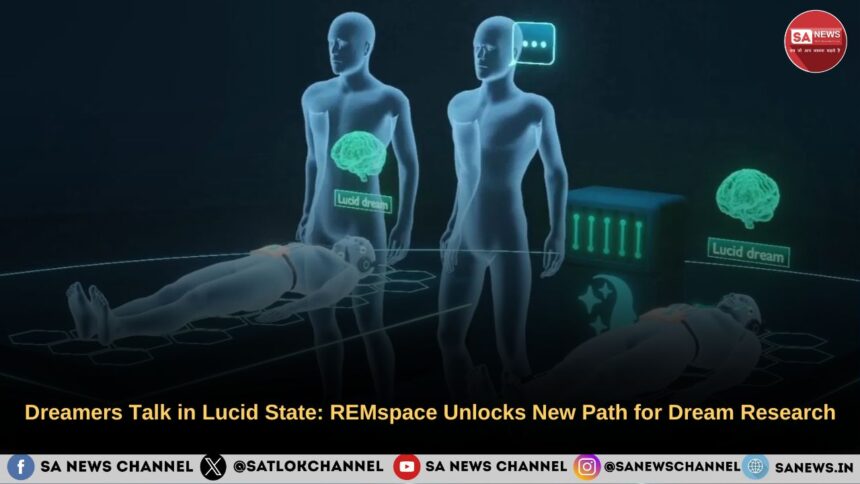In a groundbreaking experiment, two individuals successfully communicated during a lucid dream. The experiment was conducted by REMspace, a neurotechnology start-up, aiming to push the boundaries of oneirology, the study of dreams. Using advanced technology, the participants were able to exchange messages while remaining in the dream state, paving the way for future studies on dream communication and consciousness.
A Breakthrough in Oneirology Key Points
- REMspace’s experiment demonstrated two-way communication during lucid dreams.
- Dreamers accurately responded to 18.4% of auditory cues while dreaming.
- REMspace developed a unique “dream language” called Remmyo for real-time communication.
- Peer review of the experiment is still pending.
What is Oneirology?
Oneirology is the scientific study of dreams, focusing on understanding their nature, mechanisms, and effects on the mind and body. Researchers in oneirology explore topics such as how dreams occur, their psychological and neurological functions, and their relationship to waking life. This field also investigates phenomena like lucid dreaming and the role dreams play in memory and emotional regulation.
What is the Lucid State?
A lucid state occurs when a person is aware they are dreaming and can influence or control their dream environment. It offers a unique blend of consciousness within the unconscious realm, where the dreamer can interact with their surroundings while remaining asleep.
About REMspace
REMspace is an organization at the forefront of lucid dreaming research, founded by Michael Raduga. Their work focuses on exploring how communication during dreams can bridge the gap between consciousness and subconsciousness. REMspace has developed Remmyo, a language that relies on electromyography sensors to detect signals from dreamers, enabling real-time communication within dreams.
Their goal is not only to deepen the understanding of dream states but also to explore the potential psychological benefits, such as reducing nightmares, confronting phobias, and improving learning. However, these findings await further validation through peer review.
Two-Way Communication in Lucid Dreams
This experiment provided compelling evidence of two-way communication within lucid dreams. Dreamers used pre-trained methods, including specific eye movements and facial expressions, to respond to external cues while asleep.
They were able to answer simple questions, solve math problems, and give yes/no responses. With 18.4% of responses being correct, the study supports the idea that communication between the dreaming and waking world is achievable under certain conditions.
How Was This Achieved?
To facilitate communication during lucid dreams, participants were equipped with EEG caps to monitor their brain activity. These caps ensured they had entered the REM sleep stage, where lucid dreaming occurs.
While in this state, participants were presented with random words through headphones. One dreamer repeatedly uttered a specific word during their dream, which the second participant later confirmed upon waking. This demonstrated successful communication during the dream state.
What’s Next?
While the experiment has gained attention, its validity still awaits peer review. A formal review process is crucial to confirm the results and establish the credibility of REMspace’s findings. Once published in a scientific journal, this experiment could open the door to new developments in the study of dreams and consciousness.
It could also attract further investment in REMspace’s research, expanding the possibilities of lucid dream applications.
Future Scope of Lucid Dreams
The success of this experiment could unlock numerous exciting opportunities, including:
1. Therapeutic Applications: Lucid dreaming may provide a powerful tool to help individuals with PTSD, nightmares, or phobias by enabling them to reshape distressing dream scenarios.
2. Neurological Research: Understanding how the brain processes information during dreams could deepen our knowledge of consciousness and cognitive functions during sleep.
3. Dream Control: With further development, advanced techniques could enable people to intentionally create and control their dream experiences for various purposes, from therapy to entertainment.
Lucid Dreaming and Spiritual Awareness
This breakthrough experiment marks a significant milestone in the study of dreams and consciousness, with far-reaching implications for science, psychology, and even spiritual exploration. The concept of lucid dreaming, where an individual becomes aware of and controls their dream, mirrors the spiritual teachings of Jagatguru Tatavdarshi Sant Rampal Ji Maharaj ji.
His philosophy emphasizes that the physical world is an illusion (Maya), and through spiritual knowledge and devotion, one can break free from these illusions to gain control over their spiritual journey. In the same way, lucid dreamers recognize and reshape their dream state, Sant Rampal Ji’s teachings suggest that through naam jaap (chanting mantras) and true devotion, individuals can become aware of the spiritual realm and guide their soul’s journey toward salvation.
He suggests speaking with your inner self during dreams, particularly in lucid dreaming, is a powerful tool for self-reflection and personal growth. Instead of interacting with the external environment in the dream, the focus shifts to exploring your thoughts, emotions, and subconscious mind.
This can help you confront fears, gain clarity on unresolved issues, and foster deeper self-awareness. By intentionally communicating with your inner self in dreams, you can unlock hidden insights, strengthen your intuition, and promote mental and emotional healing.
This type of inner dialogue aligns with introspective practices, where lucid dreams serve as a bridge between consciousness and the deeper layers of your psyche. It’s an opportunity for spiritual and personal development, as dreamers can ask themselves questions, receive symbolic answers, and even gain a sense of peace or direction. For more spiritual information download free app Sant Rampal Ji Maharaj from the Play Store.
Frequently Asked Questions
Q: What is Lucid Dreaming?
A: Lucid dreaming is a state in which a person is aware they are dreaming and can control aspects of their dream while still asleep.
Q: What technology was used in the experiment?
A: The experiment used EEG caps to monitor brain activity and headphones to deliver auditory cues during the dream state.
Q: What is Remmyo?
A: Remmyo is a dream language developed by REMspace that uses electromyography sensors to enable real-time communication within lucid dreams.
Q: Can lucid dreaming be used for therapeutic purposes?
A: Yes, lucid dreaming is believed to have therapeutic benefits, such as helping individuals confront nightmares, manage PTSD, and reduce anxiety by allowing them to take control of distressing dream scenarios.
Q: How accurate was the communication in the lucid dream experiment?
A: In the experiment, participants responded correctly to about 18.4% of the auditory cues, demonstrating that while challenging, communication during lucid dreams is possible under the right conditions









